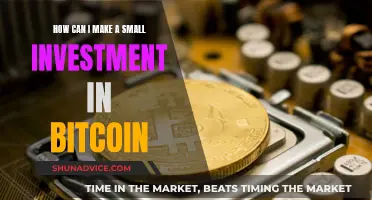
Bitcoin is a form of digital currency that uses blockchain technology to support transactions between users on a decentralised network. It was introduced to the public in 2009 by an anonymous developer or group of developers using the name Satoshi Nakamoto. It is now the most well-known and largest cryptocurrency in the world.
Bitcoin can be used as a currency or an investment. It is designed to act as money and a form of payment outside the control of any one person, group, or entity, removing the need for trusted third-party involvement (e.g. a bank) in financial transactions.
Bitcoin is mined by blockchain miners who verify transactions and can be purchased on several exchanges. It is stored in a wallet, which can be either a hot wallet or a cold wallet. A hot wallet is connected to the internet, while a cold wallet is not.
Bitcoin is a very high-risk investment due to its volatility. Its value may rise or fall dramatically over a short period, and there is no central regulator to ensure the value remains stable.
What You'll Learn

Understanding the basics of Bitcoin
Bitcoin is a form of digital currency that uses blockchain technology to support transactions between users on a decentralised network. It was created by a person or group using the name Satoshi Nakamoto, who posted a white paper on a discussion board. Bitcoin operates without a financial system or government authorities and can be used as an alternative to fiat currencies or as an investment.
Bitcoin is built on a distributed digital record called a blockchain. The blockchain is a linked body of data, made up of units called blocks that contain information about each transaction, including date and time, total value, buyer and seller, and a unique identifying code for each exchange. Each Bitcoin is a digital asset that can be stored at a cryptocurrency exchange or in a digital wallet. Each individual coin represents the value of Bitcoin's current price, but you can also own partial shares of each coin.
Bitcoin Mining
New Bitcoins are created as part of the mining process, as a reward to people whose computer systems help validate transactions. Bitcoin mining is the process of adding new transactions to the Bitcoin blockchain. It's a tough job. People who choose to mine Bitcoin use proof of work, deploying computers in a race to solve mathematical puzzles that verify transactions.
How to Buy Bitcoin
You can buy Bitcoin on a cryptocurrency exchange. You'll need to set up an account, verify your identity, and deposit money from your bank account. Once your exchange account is funded, you can buy Bitcoin. The big question is, how much Bitcoin should you purchase? Some coins cost thousands of dollars, but exchanges often allow you to buy fractions of a single coin—your initial investment could be as low as $25.
Bitcoin is a very high-risk investment because it's a volatile asset. That means that Bitcoin values may rise or fall dramatically over a very short period—even as quickly as a few hours or days. Like all cryptocurrencies, Bitcoin has no intrinsic value. It's not backed by any physical asset, like gold or silver, and there's no central regulator to ensure that the value remains stable. Furthermore, Bitcoin value isn't linked to the profits of any one corporation. The value of Bitcoin is dependent on market demand.
Pros and Cons of Investing in Bitcoin
Pros
- Cost-efficient transactions and fast speeds.
- Privacy. Transactions don't contain personal information, such as a name or credit card number.
- Decentralisation. An alternative, decentralised currency outside the control of regular banks, governing authorities or other third parties.
- Growth potential. Some investors who buy and hold Bitcoin are betting that once it matures, greater trust and more widespread use will follow, and therefore its value will grow.
Cons
- Price volatility.
- Hacking concerns.
- Not protected by SIPC (Securities Investor Protection Corporation).
- Limited inflation protection.
- Pure Bitcoin investing offers no protection.
The Basics of Bitcoin Investment Explained
You may want to see also

How to buy and store Bitcoin
There are several ways to buy Bitcoin, each with its own advantages and disadvantages. Here is a step-by-step guide on how to get started:
Step 1: Choose a Crypto-Trading Service or Venue
You will need to select a crypto exchange or trading platform to buy Bitcoin. Examples include Kraken, Binance.US, Coinbase, and Gemini. These platforms may require you to set up an account and provide personal information such as your name, address, and Social Security number.
Step 2: Connect Your Exchange to a Payment Option
You will need to fund your account before investing in Bitcoin. You can typically connect your bank account directly or link a debit or credit card. However, using a credit card to buy Bitcoin is not recommended due to high transaction fees and interest charges.
Step 3: Place an Order
Once your account is funded, you can place your first order to buy Bitcoin. The amount you invest will depend on the current price of Bitcoin and how much you want to purchase. For example, if 1 Bitcoin is worth $40,000, you would need to invest that amount to buy 1 BTC.
Step 4: Store Your Bitcoin
You can store your Bitcoin in a crypto wallet or leave it in your exchange account. There are two main types of crypto wallets: hot wallets and cold wallets.
- Hot Wallets: These are online wallets or apps that are convenient and easily accessible. However, they are more vulnerable to hacks and cyberattacks. Examples include the Bitcoin.com Wallet app and Coinbase.
- Cold Wallets: Cold wallets are small, encrypted portable devices, similar to a USB drive. They are considered more secure because they are not connected to the internet, making them less susceptible to traditional hacking methods. Examples include hardware wallets such as Trezor and Ledger.
It is recommended to use a strong password and enable two-factor authentication for added security, regardless of the storage method you choose. Additionally, only keep the amount of Bitcoin you plan to use in your hot wallet, and move the rest to cold storage for safer keeping.
Calculating Bitcoin Investment Growth: A Simple Guide
You may want to see also

Bitcoin's volatility and risks
Bitcoins Volatility and Risks
Bitcoin is a highly volatile asset, with its value fluctuating by thousands of dollars in a short period. This volatility is driven by various factors, including supply and demand, investor actions, media hype, and regulatory changes. Understanding these factors can help investors decide whether to invest in or trade Bitcoin.
Supply and Demand
Bitcoin's price, like most commodities, is heavily influenced by supply and demand. With a limited supply of 21 million coins, the closer the circulating supply gets to this limit, the higher the prices are expected to climb. As big financial players compete for ownership in a dwindling supply market, Bitcoin's price will likely be extremely responsive to their actions.
Investor Actions
As the most popular cryptocurrency, Bitcoin's demand increases as supply becomes more limited. Wealthier investors tend to hold onto their Bitcoins, preventing those with fewer assets from gaining exposure. This concentration of wealth can also drive volatility as these large investors, known as "Bitcoin whales," have the power to significantly influence the market if they liquidate their holdings.
Media Hype and Regulatory Changes
Media outlets, influencers, and industry leaders play a significant role in creating investor concerns or excitement, leading to price fluctuations. Additionally, regulatory changes and government agency views on cryptocurrency can also impact Bitcoin's price. For example, China's ban on cryptocurrency transactions in 2021 caused a significant drop in Bitcoin's value.
Risks
The high volatility of Bitcoin makes it challenging to use as a medium of exchange or a unit of account. The extreme price fluctuations can make it unsustainable for businesses to accept Bitcoin as a means of payment, as they would have to continuously update their prices to avoid significant losses.
Bitcoin is also subject to various risks, including security risks from hacks and cyberattacks, fraud, and a lack of insurance from entities like the Securities Investor Protection Corporation (SIPC) or the Federal Deposit Insurance Corporation (FDIC).
Opportunities
Despite the risks, Bitcoin's volatility also presents opportunities for traders and investors. Its volatile nature makes it ideal for those looking for short-term gains or wanting to capitalise on its price movements. Additionally, the ability to invest in fractions of a Bitcoin lowers the barrier to entry, allowing more people to invest.
A Beginner's Guide: Investing in Bitcoin with Robinhood
You may want to see also

Bitcoin mining
Miners use proof of work, deploying computers in a race to solve mathematical puzzles that verify transactions. The Bitcoin code rewards miners with Bitcoin for each new block added to the blockchain. The reward for successfully validating a block is currently 3.125 Bitcoin, worth around $196,875 as of April 2024.
The process is designed to be challenging, with the Bitcoin code written to make solving its puzzles increasingly difficult over time. As a result, Bitcoin mining now requires powerful computers and access to massive amounts of cheap electricity to be successful.
The mining process also consumes a large amount of energy, leading to concerns about its environmental impact. The competitive nature of Bitcoin mining has resulted in the development of specialised mining machines, known as Application-Specific Integrated Circuit (ASIC) miners. These machines can cost anywhere from several hundred to tens of thousands of dollars.
To increase their chances of success, miners often join mining pools, combining their computational resources. By working together, miners in a pool have a better chance of solving the puzzles and receiving the Bitcoin reward.
The Bitcoin mining process serves the crucial function of validating and confirming new transactions on the Bitcoin blockchain. It is also how new Bitcoins are introduced into the system, with the reward for mining a block halving roughly every four years.
Litecoin Cash: A Smart Investment Move?
You may want to see also

Bitcoin's future
Recent Performance
Bitcoin has experienced a turbulent year, shedding approximately 65% of its market value. It endured events such as the Terra Luna crash, the FTX decline, macroeconomic factors, and legal issues with Binance. Despite this, Bitcoin has shown a remarkable recovery, and as of August 5, 2024, it is trading at around $50,000, with a market capitalization of over $1 trillion.
Expert Predictions
Experts' predictions for Bitcoin's future vary. Some believe that Bitcoin could reach $100,000 by the end of 2024, driven by factors such as increasing adoption, the approval of Bitcoin ETFs, and the weakening of traditional fiat currencies. Others are more cautious, stating that the psychological resistance at the $100,000 mark could cause the price to pause or even pull back. Veteran trader Peter Brandt predicts a market top of $150,000 by the end of 2025, based on historical halving cycles.
Bitcoin Halving
The Bitcoin halving event, which occurs approximately every four years, cuts the reward for miners by 50%. The most recent halving took place on April 20, 2024, and historically, these events have been bullish for Bitcoin's price. With a limited supply of Bitcoin, the decreasing rate of new coins entering circulation may push the price higher.
Institutional Adoption
The approval of Spot Bitcoin ETFs has been a significant factor in Bitcoin's growth, attracting interest from retail investors. Additionally, large institutions are increasingly treating Bitcoin as a digital gold, using it to hedge against market volatility and inflation. This trend is expected to continue, further boosting Bitcoin's value.
Technical Analysis
Technical analysis of Bitcoin's price movements suggests that it may experience short-term bearish trends but could see bullish momentum in the long term. For example, the 200-day moving average on the weekly timeframe is rising, indicating potential sustained upward momentum.
Regulation and Adoption
The regulatory landscape for Bitcoin and cryptocurrencies is evolving. While some countries, like India, are bringing crypto transactions under anti-money laundering laws, others, like the U.S., are seeking to impose regulations without stifling the industry. As the regulatory environment clarifies, Bitcoin's future may become more certain.
In summary, Bitcoin's future is difficult to predict with certainty. Its price is expected to remain volatile in the short term, but the long-term outlook is positive, with the potential for significant price appreciation. As always, investing in Bitcoin carries risks, and investors should carefully consider their financial circumstances and tolerance for risk before making any investment decisions.
Acorns Invest in Bitcoin? Exploring Acorns' Crypto Offerings
You may want to see also
Frequently asked questions
Bitcoin is a cryptocurrency, a new kind of payment network and money. It was created by a person or group, going by the username Satoshi Nakamoto, who posted a whitepaper on a discussion board. Bitcoin operates without a financial system or government authorities. It can be used as an alternative to fiat currencies or as an investment, utilising peer-to-peer transfers on a digital network that records and secures all transactions.
You can buy Bitcoin on a cryptocurrency exchange, such as Coinbase, Binance or Kraken. You will need to set up an account, verify your identity, and fund your account with a bank transfer. You can then purchase Bitcoin and store it in a wallet, either a hot wallet (connected to the internet) or a cold wallet (offline).
No investment is inherently good or bad. It depends on your risk tolerance, investment strategy, and financial goals. Bitcoin is a very high-risk investment due to its volatility. Its value is dependent on market demand, so it can rise or fall dramatically in a short space of time.
You can store your Bitcoin in a wallet, either a hot wallet or a cold wallet. A hot wallet is connected to the internet and is more vulnerable to hacking. A cold wallet is an offline device, such as a USB drive, that stores your Bitcoin. Cold wallets are considered safer but hot wallets are more convenient.







